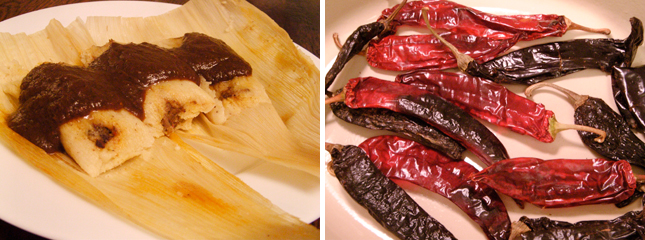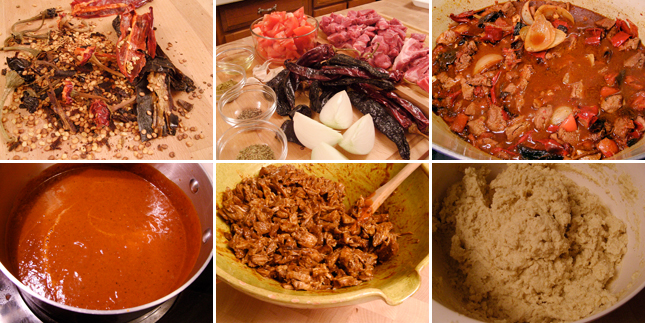Tamales - Smoked Red Chili & Pork

Tamales take a little time to make and because of this they are usually eaten on special occasions with friends and family. This recipe makes a large amount; about thirty-five. You will need quite a large braising pan to accommodate all this meat but it can easily be halved if you don’t have a large pan or if you just want to make a smaller amount.
This is a traditional Mexican recipe- it's very rustic. It may seem complicated at first but if you do it once the second time goes much quicker and once you understand the method you can experiment with the filling.
Recipe by Amber Share
Serves 10
For this recipe half Pasilla and half New Mexico Red (considered medium-hot and mild) were used.
Ingredients for filling:
2 tablespoons vegetable oil
2 pounds pork shoulder, cut into 3 inch cubes plus bones if available
4 ounces whole dried chilis, Pasilla, Guajillo, New Mexico or Ancho
1 white onion, peeled and quartered
6 cloves garlic, peeled and roughly chopped
1 tablespoon ground cumin
1 tablespoon dried oregano
1 teaspoon black pepper, preferably freshly ground
1 1/2 teaspoons salt
5 tomatoes, roughly chopped, or 1 28 ounce can diced
Other ingredients:
hot water
40 dried corn husks
4 cups instant corn masa (Maseca works well)
4 cups lukewarm chicken or vegetable broth
2 teaspoons baking powder
1 teaspoon salt
1 1/3 cups vegetable shortening
large steamer

Filling: Briefly toast the peppers in a braising pan (large enough to hold all ingredients) on the stovetop over medium heat until they start to smoke and their flavor is released turning to prevent burning. If your peppers start out dark and somewhat dry (as my Pasillas did) they will require less time in the pan. Turn the fan on to prevent your kitchen from filling up with smoke. Remove from pan and cool.
Turn the heat up to medium-high. Add 2 Tablespoons vegetable oil to the pan. Add the meat (and bones if available), brown on all sides. Set pan aside. (Don’t worry if you don’t have any bones. I only add them if I have them. The marrow can add flavor but it will be delicious without as well.)
Wearing gloves, tear tops off chilis and remove seeds. Tear into 2-3 inch pieces.
Put the pan back on the stove over medium-high. Add the rest of the filling ingredients. Stir. Add water until it reaches half way up the meat. Turn to medium-low and simmer until very tender - about 2 hours. Remove pan from heat and set aside.
Pick out the meat and place on a cutting board. Discard the bones. Reserve the liquid and vegetables until you are ready to make the sauce. Shred the meat when it is cool enough to handle.
Masa: Soak the corn husks, submerged in hot water, in a large pot for 30 minutes.
To make the masa follow the directions on your bag of masa. Below are the directions from a bag of Maseca.
Combine masa, baking powder and salt in a bowl. Work broth in with your fingers to make a soft, moist dough. In a small bowl beat shortening until fluffy. Add masa and beat until dough has a spongy texture.
Sauce: Blend the liquid and vegetables that the meat cooked in until very smooth. In a saucepan reduce slightly. Add salt to taste. Start with 1 teaspoon and increase in 1/2 teaspoon increments. I added 3 teaspoons to mine but yours may vary depending on how much water you added.
Assembly: Remove the soaking husks from the water and lay to dry on paper or cloth towels.
In a bowl add the meat and about 1 cup sauce. Mix well.
Take some of the masa in your hand and smear it onto the middle of a husk. Place a small amount of filling down the center of the masa. Lift the bottom of the husk up rolling the masa to cover the filling and meet the other side. Then bring the top of the husk down. You will have a cylinder. Fold the long sides in then turn it over to hold it together. Some people tie the packages with strings of husk. I don’t bother. As long as it is resting on it’s own weight upside down it will stay together. (It’s hard at first but after a couple you will get the hang of it. It is a lot like making sushi.)
Cooking: You will need a steamer to cook the tamales. It is okay to double layer them as long as they are arranged so that steam will move all around them. A large multi-pot with an additional steamer insert on top works well. This gives you two layers on which to steam, one high and one low. You could also use two separate pots with vegetable steamers inside, a Chinese bamboo steamer, or just cook them in smaller batches in one pot.
Start the water, in which they will steam, boiling. Add a couple inches of water to the pot but not enough that the tamales will get wet. When the water boils place the tamales in the steamer. Cover and steam for 40 minutes or until the masa pulls away from the husk easily.
Serve the tamales by opening the husks and spooning the sauce over them while piping hot. They can be stored in the fridge or frozen and reheated by steaming.






 Share Article
Share Article